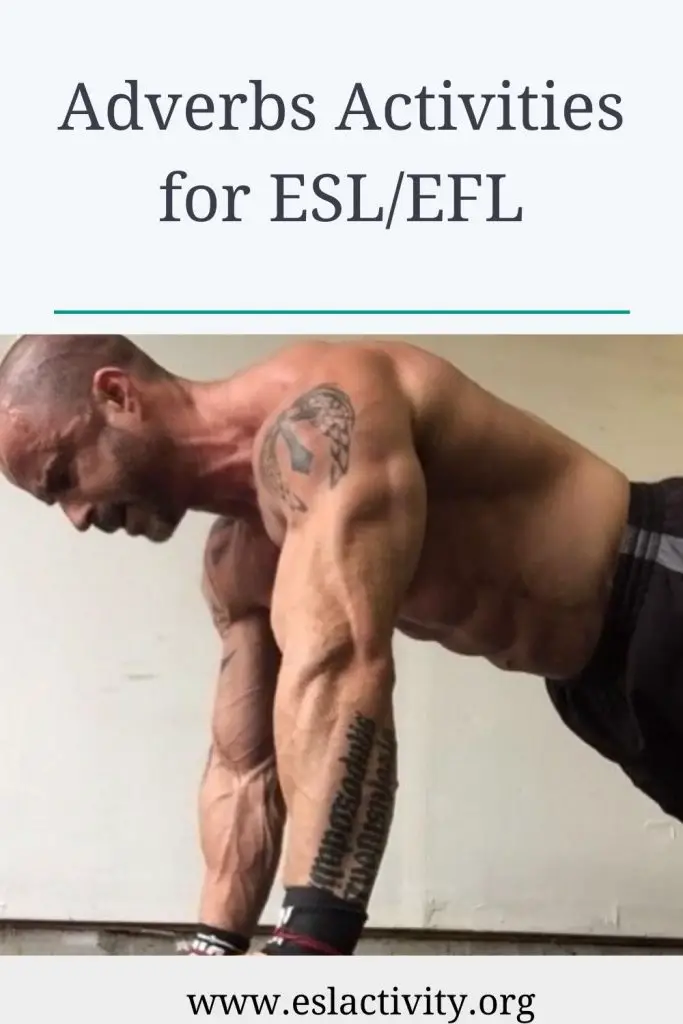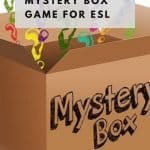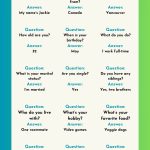If you’re looking for an adverb activity or game to use in your ESL/EFL classes, then you’re certainly in the right place. We have some great options for that, along with worksheets, lesson plans, and recommendations for online practice. Keep on reading for all the details you need to know.

Adverbs ESL
Adverbs ESL Games and Activities
Let’s get into the best ESL adverbs activities to try out with your students today.
#1: Find Someone Who Bingo
I often use this as an icebreaker game but it’s a nice way to practice with adverbs as well. Fill the board with statements that contain adverbs such as:
- Eats slowly
- Walks quickly
- Laughs loudly
- Speaks quietly
- Etc.
Then students have to find people that match the descriptions among their classmates. Try out this interactive and engaging ESL activity:
www.eslactivity.org/find-someone-who-bingo-game-for-esl-students
#2: Adverbs Me Too!
Try out this simple speaking game that’s ideal for getting students to practice using adverbs. Each student can think of a few sentences related to their daily life and each one must include an adverb. For example:
- I eat breakfast quickly.
- I like to walk home from school slowly.
- My mom yells at me if I don’t play with my younger brother nicely.
Then, when a student says one of their statements, if other students are the same, they have to stand up and say, “Me too!” Learn more about it:
www.eslactivity.org/me-too-esl-speaking-listening-activity
#3: The Flyswatter Adverb Game
This is a fun game for kids that helps them work on using adverbs. Write down a bunch of adverbs on the whiteboard in random fashion.
Then, one student from each team comes up to the front and grabs a flyswatter. Say another word and students have to choose an adverb that could modify it well. For example, on the whiteboard, there might be the word slowly. Then, you could say walk and students could slap the word slowly but they couldn’t slap accidentally. Replace the adverb with another one and the game continues with the next students.
www.eslactivity.org/flyswatter-esl-vocabulary-game-for-kids
#4: Adverbs Songs and Chants
When teaching kids, I love to use songs and chants in my classes. They’re a great way to make English grammar or vocabulary more memorable. The good news is that there are lots of great adverb songs and chants on YouTube that are perfect for children. Here’s just one example:
https://www.youtube.com/watch?v=aUu165jHuWI
#5: Dictogloss Adverb Game
If you teach higher-level ESL/EFL students, then consider using this challenging listening activity. Find (or write) a passage that contains lots of different kinds of adverbs. Then, put students into pairs and read out the passage at a faster than normal pace. Students have to take notes and then compare with a partner with the goal being to recreate what they just heard.
Read it out again and students do the same thing. Finally, they can compare what they have with the original. At this point, I get students to work together again to find all the adverbs in the passage. Check it out:
www.eslactivity.org/dictogloss-esl-listening-and-speaking-activity
#6: Error Correction Relay Race
I like to use this relay race to turn something old (error correction) into something fun and exciting. Make a passage filled with various errors but many of them should relate to adverb usage. Then, students have to work together to find the errors and make the required corrections. Learn more about it:
www.eslactivity.org/error-correction-relay-race
#7: Adverb 3 in a Row
Fill up a 6×6 grid with various target adverbs (a different one for each square). Then, students have to take turns choosing one of the adverbs and making a sentence with it. If they’re able to do this, they can mark the square. The goal is to get three in a row (similar to X’s and O’s). If not, the square remains unmarked and is still available.
Continue until the time is up or a certain number of points have been reached.
#8: Adverbs ESL Listening Lesson
A nice way to focus on adverbs is through a listening lesson. Find a conversation between two people that contains a lot of the target vocabulary. Or, somebody doing something similar (it could be you!). Then, plan an entire lesson around it. It’s easier than you might think:
#9: Mixed up Sentences
This is a nice ESL activity that can be used to focus on word order within sentences. Make up some sentences that contain the target adverbs and then mix them up. Students have to work together to unscramble the sentences. Check out this simple activity here:
www.eslactivity.org/mixed-up-sentences-english-grammar-activity
#10: Listening for Adverbs
Teaching listening can be quite an overwhelming thing! However, one of the key strategies for both teachers and students is to focus on one specific thing. In this, it might be adverbs. I generally prefer to do this at the end of the class where I’ve been teaching about a certain kind of adverbs. Then, I’ll play the listening passage and have students take note of the adverbs they hear. I get them to compare with a partner and then the entire class. Then, I play it again and students can again take note of what they hear.
www.eslactivity.org/english-listening-tip
#11: Charades with Verbs and Adverbs
This is like a typical charade game but it uses verbs and adverbs. For example:
- walking slowly
- eating quickly
- running awkwardly
- jumping gracefully
- driving safely
#12: Odd One Out
A nice way to get students to recognize what an adverb is, and isn’t is with this simple game. Include 3 adverbs and 1 word that isn’t. Try it out:
#13: English Sentence Structure Games and Activities
Time spent on building better English sentences will never be wasted time. Where to put adverbs is a little bit tricky because there are no hard and fast rules and it really does depend on what kind of adverb we’re talking about.
If you want to help students make better sentences have a look at some of the top recommendations here:
www.eslactivity.org/sentences-structure-games
#14: Is that Sentence Correct Adverb Activity?
This is a simple error correction activity that can help students work on the placement of adverbs in a sentence. Make some sentences, some of which have errors related to adverbs. Students have to decide if the sentence is correct, or not. If it’s incorrect, they have to make the required changes. Take a look at it here:
www.eslactivity.org/english-grammar-activity-is-that-sentence-correct
#15: Reading Lesson Plan and Adverbs
Parts of speech are often introduced in ESL textbooks through either a listening or reading passage. It’s certainly possible to design an entire lesson around a reading and use it to focus on adverbs and their usage. To find out all the steps and how to do this, have a look here:
www.eslactivity.org/an-esl-reading-lesson-plan-template

ESL adverb
#16: Closest in Meaning Adverb ESL Activity
This is a simple reading activity that can be used to focus on adverbs. Write one target sentence and then three other sentences. One of those other sentences should be quite closely related in meaning while the other two are less similar. Students have to choose the one that’s the best fit.
Of course, focus on adverbs and include them in these sentences. It’s a nice way to review new vocabulary too. Have a look:
Closest is Meaning ESL Activity.
#17: Word Association Adverb Practice Activity
Try out this fun brainstorming/mind-mapping activity to elicit lots of adverbs that students already know. Write a verb on the board such as walking. Then, circle it. Get students to shout out adverbs that can describe this activity and group them together if appropriate.
After that, have students work in small groups to come up with adverbs for different verbs. Find out more:
Word Association ESL Activity.
#18: The Flyswatter Game
This is a fun vocabulary game for any age. Write up a bunch of verbs (or adverbs, depending on what your goal is). If you write verbs on the board, say an adverb. A student has to slap an adverb that will fit (or vice-versa).
For example:
- Slowly (slap run)
- Eat (messily)
Check it out here:
#19: A to Z Alphabet Game
This is a simple warmer or timer-filler activity that can be used to review adverbs. State a verb such as eating and then students have to come up with as many adverbs as possible in a certain amount of time, one for each letter than can describe that activity. For example:
m= messily
n= noisily
q= quickly
s = slowly
Try it out:
#20: Freeze Group Writing Activity
If you want students to get some practice with using adverbs to make writing more interesting, then consider using this group writing activity. Students have to work together to create interesting stories that will be read out loud to the class at the end.
In this case, I require that each sentence contains at least one adverb, and the more descriptive, the better! It’s a fun way to get students to use these words in a creative way. Find out more details:
#21: Adverb ESL Speaking Lesson Plan
It’s easy to plan ESL lessons for any topic or grammar point, including adverbs. Have a look at this video for all of the steps to follow:
#22: Adverb Obstacle Course
Create an obstacle course in the classroom or outside and place adverb cards at different stations. Each card has an action written on it, such as “jump high,” “run slowly,” or “spin quickly.” Students navigate the course and perform the actions as instructed on the adverb cards.
#23: Adverb Slam
Write various adverbs on sticky notes and stick them to the board. Divide the class into teams and give each team a fly swatter. Call out a sentence, and the first student from each team must find and “slam” the corresponding adverb with the fly swatter. The team that correctly slams the adverb gets a point.
#24: Adverb Toss
Write different adverbs on small pieces of paper and place them inside a box or container. Create a target on the board with different point values. Students take turns picking an adverb and using it correctly in a sentence. Based on the accuracy and creativity of their sentence, they can toss a ball or beanbag at the target to earn points.
#25: Adverb Gallery Walk
Prepare posters with sentences or short paragraphs that include adverbs. Hang the posters around the classroom. Divide the students into groups and provide them with markers or sticky notes. Each group rotates around the room, reading the sentences and identifying the adverbs. They can mark the adverbs or write their own sentences using the adverbs.
#26: Adverb Story Chain
Begin a story by creating a simple sentence that includes an adverb. For example, “The cat ran quickly.” Each student adds to the story by creating a new sentence that includes an adverb and continues the narrative. The students form a chain, with each student contributing to the story using an adverb.
Online Practice for Adverbs
If your students want some extra practice with using adverbs, here are some of the best options for online practice:
Adverb ESL Lesson Plans
If you’re a teacher, then you’ll already know how much time it can save you to use lesson plans that other teachers have already made. Here are some of the top picks for ESL adverbs lesson plans:
Adverbs ESL Worksheets
Another way to save a ton of time is to use ESL adverb worksheets that other teachers have already put together. Here are some of the best options to choose from:

Teaching adverbs
Teaching Adverbs ESL FAQs
There are a number of popular questions that people have about teaching adverbs to English learners. Here are the answers to some of the most common ones.
What is an Adverb ESL?
For ESL/EFL learners, an adverb is a part of speech that describes or modifies a verb, adjective, adverb, clause or sentence. They often end with -ly and can be found almost anywhere in a sentence. They generally answer questions related to when, where, how, and to what extent.
What are the 5 types of Adverbs?
In English, the 5 types of adverbs are as follows:
- adverbs of degree
- frequency
- manner
- place
- time
Do all adverbs end in -ly?
Although many adverbs end in -ly, not all of them do. For example, “very” is a common degree adverb that doesn’t end in -ly. Or, “hard” can be an adverb in the sentence, “I worked hard.”
Where are adverbs in a sentence?
In a sentence, adverbs can be found in various places, depending on the kind of adverb it is. They can sometimes be found after the main verb, before the main verb or between the auxiliary verb and an infinitive.
What are fun ways to teach adverbs?
There are a number of fun games and activities that can be used to teach adverbs. They include things like board games, running dictation, bingo, board races, worksheet relay races, and more.
Tips for Teaching Adverbs to English Learners
Teaching adverbs to ESL learners can be a rewarding experience. Here are some tips to effectively teach adverbs:
Introduce adverbs through examples
Begin by providing clear and relatable examples of adverbs in action. Show how adverbs modify verbs, adjectives, or other adverbs to provide more information about how, when, where, or to what extent an action is performed.
Teach different types of adverbs
Explain the various types of adverbs, including adverbs of manner (e.g., slowly, beautifully), adverbs of frequency (e.g., always, often), adverbs of time (e.g., yesterday, now), adverbs of place (e.g., here, there), and adverbs of degree (e.g., very, extremely). Make sure to provide examples and practice activities for each type.
Emphasize word order and placement
Highlight the placement of adverbs in sentences. Teach that adverbs often come before the main verb, after the verb “to be,” and after auxiliary verbs. Help students understand the difference between adverbs of frequency that typically come before the main verb and adverbs of manner that usually come after the main verb.
Use visuals and gestures
Utilize visual aids, such as flashcards or pictures, to illustrate adverbs and their meanings. Incorporate gestures or body movements to help convey the meaning of adverbs of manner. This multisensory approach enhances understanding and retention.
Provide context and real-life examples
Contextualize adverbs by incorporating them into meaningful and relatable contexts. Use real-life examples, such as describing actions or daily routines, to demonstrate the use of adverbs in authentic situations. Encourage students to come up with their own examples.
Practice with sentence exercises and adverbs
Engage students in sentence-building exercises and practice activities. Provide sentences with missing adverbs, and have students fill in the gaps with suitable adverbs. This helps reinforce the correct usage and placement of adverbs in context.
Encourage adverb modification
Teach students how to modify adjectives or other adverbs with adverbs of degree. Explain how adding an adverb of degree can change the intensity or degree of an action or description. Encourage students to experiment with different degrees of intensity in their own speech and writing.
Incorporate adverbs in speaking activities
Include speaking activities that require students to use adverbs in their conversations. For example, provide discussion prompts or role-play scenarios where students need to describe actions, habits, or experiences using appropriate adverbs.
Analyze adverbs in texts
Analyze adverbs found in reading passages, stories, or dialogues. Discuss the purpose and effect of using specific adverbs in those texts. This helps students develop their reading comprehension skills and understand how adverbs contribute to the overall meaning and style of a piece of writing.
Provide feedback and reinforcement
Offer constructive feedback and correction when students make errors in using adverbs. Regularly review and reinforce the concepts through various activities, including quizzes, games, and writing tasks. Celebrate students’ progress and encourage them to incorporate adverbs in their language production.
Did you like these ESL Adverbs Games and Activities?
- Amazon Kindle Edition
- Bolen, Jackie (Author)
- English (Publication Language)
- 187 Pages - 03/09/2016 (Publication Date)
Yes? Then you’re going to love this book over on Amazon: 101 ESL Activities for Teenagers and Adults. The key to better TEFL classes for teens or adults is a variety of interesting, engaging and interactive activities and this book will help you get there in style.
Keep a copy on the bookshelf in your office to use as a handy reference guide. Or, take the digital version with you on any device to your favourite coffee shop for some serious lesson planning on the go. Finally, consider listening to the audio version when commuting to work for some inspiration.
Whatever the case, get ready for some ESL teaching awesome in your life with 101 ESL Activities. Yes, it really is that easy. Pick up your copy of the book today:
Have your Say about Teaching Adverbs for ESL/EFL
What’s your top game or activity for teaching adverbs? Is it one of the options from this list or do you have another one that you’d like to recommend? Leave a comment below and let us know what you think. We’d love to hear from you.
Also be sure to give this article a share on Facebook, Pinterest, or Twitter. It’ll help other busy English teachers, like yourself, find this useful resource.
Last update on 2022-07-17 / Affiliate links / Images from Amazon Product Advertising API





